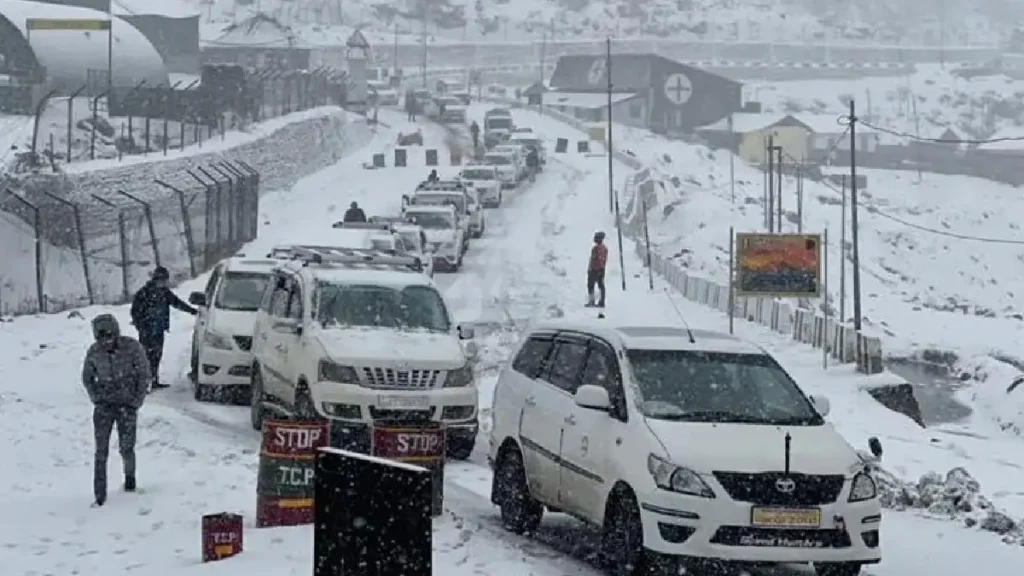Over 200 Vehicles Safely Evacuated After Sudden Snowfall in Sikkim
A sudden and intense snowfall recently trapped over 200 vehicles in Sikkim’s high-altitude regions. The unexpected weather event caught travelers and local authorities off guard. However, authorities responded quickly and ensured the safe evacuation of all stranded vehicles and their passengers.

The snowstorm, which impacted major roads and remote areas, brought strong winds and freezing temperatures, creating hazardous driving conditions, especially on Sikkim’s mountainous roads. The snow covered roads leading to popular tourist spots like Nathula, near the Indo-China border, causing major traffic congestion. As the snow accumulated rapidly, it became increasingly dangerous for anyone attempting to drive.
Swift Emergency Response and Safe Evacuation
Local agencies, including the Sikkim Police and Border Roads Organisation (BRO), sprang into action as soon as the snowstorm hit. They activated a well-coordinated evacuation plan to help stranded drivers and passengers. Rescue teams, equipped with snowplows and specialized vehicles, worked tirelessly to clear the roads and guide vehicles to safety.
Many vehicles got stuck due to icy conditions and poor visibility, making it difficult to move forward. Despite the challenges, the rescue teams successfully cleared the blocked roads. Authorities continued working even as the snowstorm raged, prioritizing safety. In the end, they evacuated all 200 vehicles safely, and no major injuries were reported. The stranded passengers, including many tourists, received food, warmth, and shelter during the evacuation. Local hotels and guesthouses opened their doors to accommodate travelers.
Nathula Border Closed for Safety
Authorities have suspended all travel permits for Nathula, a high-altitude pass on the Indo-China border, as a safety precaution. At over 14,000 feet, Nathula is notorious for its extreme weather, especially during the winter months. This recent snowfall made the area impassable, so the local government decided to close the border temporarily to avoid any accidents.
The route to Nathula quickly became unsafe, with snow accumulating at a fast pace. Authorities halted all travel to the area until conditions improve. They emphasized that continuing travel could have led to dangerous situations, particularly for those unprepared for the harsh conditions at such high altitudes.
Though the closure may affect some travelers’ plans, local officials believe it is essential to avoid potential risks. They will reopen the route once they assess the weather and deem it safe to do so.
The Impact on Tourism
Sikkim, with its stunning landscapes, vibrant culture, and proximity to the Indo-China border, has long been a popular tourist destination. However, tourism in the region depends heavily on weather conditions, particularly in the winter months. Snowstorms and heavy rainfall can disrupt travel plans, as travelers have learned during this recent snowfall.
Many tourists had to alter their itineraries as a result of the snowstorm. Some could not visit Nathula, while others got stranded due to the worsening weather. Despite the setbacks, experts expect Sikkim’s tourism industry to recover swiftly. The region’s natural beauty and cultural appeal will continue to attract visitors, and local authorities are committed to ensuring safe travel conditions for all tourists.
Role of Local Authorities and Rescue Teams
The efficient and coordinated response of local authorities and rescue teams proved crucial in managing the snowstorm’s impact. The Border Roads Organisation (BRO) played a key role in clearing snow from the roads, enabling vehicles to move safely. In addition, the Sikkim Police managed traffic and provided assistance to stranded travelers.
Local communities also offered support by providing food and shelter to those affected by the snowstorm. The collective effort from rescue teams, local authorities, and the public helped minimize the snowstorm’s impact, ensuring that everyone was safe.
Looking Ahead
Although the snowfall disrupted travel plans, it highlighted the importance of preparedness and effective disaster management. Sikkim’s ability to respond quickly and effectively shows that the region is ready to handle unpredictable weather events.
Travelers planning to visit Sikkim should stay informed about weather conditions and travel advisories. They should always check with local authorities before setting out, especially during the winter months when weather can change unexpectedly.
Snowstorms are likely to continue for the next few months. Local authorities assured the public that they will continue monitoring the situation and take necessary steps to keep everyone safe. As the snowstorm fades, Sikkim’s tourism industry will likely bounce back, and its residents will continue to prove their resilience and hospitality.






